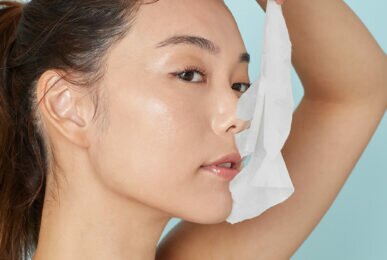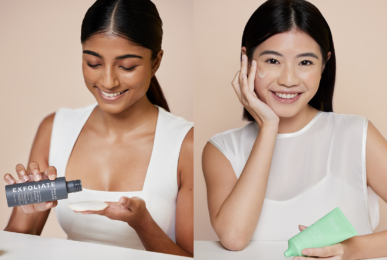As part of La Mer’s Blue Heart Campaign 2021, we speak to one of the most extraordinary, multi-hyphenated young women in ocean conservation today: Dr. Ayana Elizabeth Johnson.
2021 has been quite a record year for sustainability. From hitting long-anticipated green milestones, to more key stakeholders joining hands for the Earth, and moving forward on a post-COVID world; some might even argue that the pause on tourism and international commerce from the pandemic has ironically, provided a much needed breather for the environment. The green (and blue) movement in beauty especially, has been burgeoning — and we’re not complaining. Where new indie labels are riding high with the sustainability wave, the old guards are taking extraordinary steps towards greater environmental conservation.
In the wake of World Oceans Day 2021, La Mer’s Blue Heart Oceans Fund — which was started in 2017 to support ocean preservation — proves that the creators behind our iconic Crème de la Mer are unmatched on fronts beyond luxury skincare. We speak to one of the most extraordinary, multi-hyphenated young women in ocean conservation today and La Mer Blue Heart 2o21 ambassador, Dr. Ayana Elizabeth Johnson — a marine biologist, policy expert and conservation strategist. We take a deep dive on what it’s like pursuing climate justice, why you should stop seeing the ocean as a victim, and how to really contribute to its conservation.
1. Tell us a bit more about yourself! What do you do and what are you currently up to?
I’m a marine biologist, climate policy nerd, writer and a Brooklyn native! I’ve co-founded two non-profits – policy think tank Urban Ocean Lab and climate initiative the All We Can Save Project. I also co-created the podcast How to Save a Planet.
2. Tell us a bit more about your backstory. How did you get started on this journey, how and when did you realise ocean conservation was your calling?
I fell in love with the ocean when I was 5 years old, on a family vacation to Key West, Florida. I saw a coral reef through a glass bottom boat, got to hold a sea urchin in my hand, and my mind was blown. So I decided on the spot to become a marine biologist. I remain madly in love with nature, and my work has shifted from science to strategy, policy, media, and community-building for ocean and climate solutions. What keeps me in this line of work is my deep concern for the future of coastal communities, love of coastal cultures, and desire to contribute to solutions for our climate crisis.
3. In your opinion, what is the state of the ocean right now?
The ocean has massively buffered the impacts of climate change and it can’t take much more.
For example, it has absorbed over 90% of the excess heat trapped by greenhouse gases and around 30% of the carbon dioxide we’ve emitted by burning fossil fuels. All of this has changed the very chemistry of the oceanic waters — dramatically and for the worse — threatening our oceanic biodiversity. Additionally, every year approximately 8 million tons of plastic (and rising) end up in our ocean, harming marine life and getting incorporated into the food chain. There is also rampant overfishing and habitat destruction. The state of the ocean is quite dire.
4. How aware are we of this (the state of our oceans), really?
People seem to generally know that the ocean is no longer very healthy, but most people don’t know the details of that. We often focus on the ways in which the ocean puts up with endless waves of abuse e.g. climate change, pollution, overfishing, habitat destruction, deep sea mining…
For decades the ocean has been talked about as a victim of climate change and sometimes as a threat. It’s time to flip the script.
We need to value the ocean as a hero, as a source for climate solutions. From protecting and restoring coastal ecosystems that absorb tons of carbon, protecting us from storms, to producing clean and renewable energy from offshore wind, as well as farming the ocean regeneratively to support a sustainable food system. Ocean-based mitigation options could provide 21% of the greenhouse gas emission reductions needed by 2050, to reach the goal of remaining below 1.5 Celsius of global warming.
5. You’ve worked extensively on ocean conservation. From being a founder of NGO Urban Ocean Lab, to editing the climate anthology All We Can Save, to advising and advocating for policy change. Is there a milestone you’re particularly proud of?
I am super into the Green New Deal. It is a bold framework that acknowledges that climate change, inequality, employment, and health care are actually all intertwined. But the Green New Deal has a big blue gap: the ocean. So I collaborated with colleagues to co-create a Blue New Deal Plan and other resources for integrating the ocean into climate policy. The ocean must play a larger role in climate policy. Our food security, jobs, economy, safety, and not to mention cultures, depend on the ocean. These documents lay the groundwork for taking the ocean from an unsung solution to policy cornerstone.
6. What has been the most challenging about your journey thus far?
One exciting challenge is connecting the dots in a new way to reach wide audiences and convey the importance and value of ocean resources. Not just for ocean conservation — but for livelihoods, culture, food and national security. I try to convey complex information clearly and help people find their roles in climate solutions.
7. You’ve written a lot about social justice, as you have climate justice. How do they come together for you and why is the conversation imperative?
It has been well-documented that poor communities and communities of colour endure disproportionate exposure to toxic air, land, and water. New Orleans, Flint, Standing Rock, and countless places in between exemplify the need to prevent such communities from bearing the brunt of environmental devastation. Polling by Yale and George Mason has shown that 49 percent of white people are concerned about climate change, compared to 57 percent of Black people and 70 percent of Latinx people.
Failing to prioritise engaging people of colour is a losing strategy, because you’re not reaching out to the people who already care, who are already environmentalists. This is why it has been so essential to bring a diverse set of voices and perspectives to the table. To address the largest challenge humanity has faced we need the biggest, strongest team.
8. You wear many hats, what does work-life balance look like for you? (What does “me-time” look like, how do you unwind?)
I would not say that I am balanced! It’s a blessing and a curse to have the two so closely intertwined. Jobs and careers change, and you don’t want to lose yourself when it does. But due to the interdisciplinary nature of what I do, everything in my life ends up being relevant to the work. When I listen to music, I think about how art can help us make a message more effective. Or if I’m reading an article, I’m thinking about what makes it compelling.
To truly recharge and unwind, I buy into the philosophy of biophilia. For me it’s about being outside — watching my chickens, going to the ocean, the mountains. There is a health benefit, but it also helps me intellectually. When my mind is relaxed, it works in more interesting ways.
9. How can we start getting more involved in ocean conservation and climate justice?
There are so many ways to get involved. But first, ask yourself: What are you good at? What are your special skills that you can contribute? Because we don’t all need to be doing the same things. So don’t just look for generic ways you can help, but for ways in which you are specifically valuable.
Also, there is so much that needs to be done! So when you’re thinking about how to contribute, think about how your efforts can be a part of something larger than yourself.
Think beyond reducing your own carbon footprint and plastic use. Instead, think about systems change. The question is less “What can I do?” and more “What can we do?”
10. Who and/or what inspires you?
Two people come immediately to mind. First, Rachel Carson, the self-taught scientist and author of Silent Spring, whose science-based activism overcame sexism and corporate lobbying, which led to the ban of DDT and the regulation of pesticides.
Second, my mom, Louise Maher-Johnson, a public high school English teacher for 37 years who is now a regenerative farmer. My mom raises heritage chickens and grows vegetables with her Skyhill Farm, creating an example of a way we can nourish and be nourished by the earth.
—
Stay in the loop of Dr. Ayana Johnson’s cause here.
This interview is brought to you in partnership with La Mer’s Blue Heart Campaign 2021, read more about La Mer’s support for ocean conservation here! Discover Crème de la Mer and the rest of La Mer’s range in-stores at La Mer boutiques.
Take care,
Melisa















